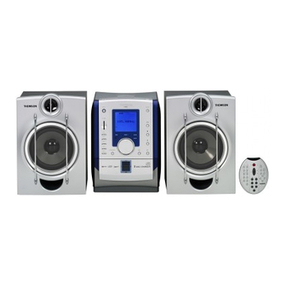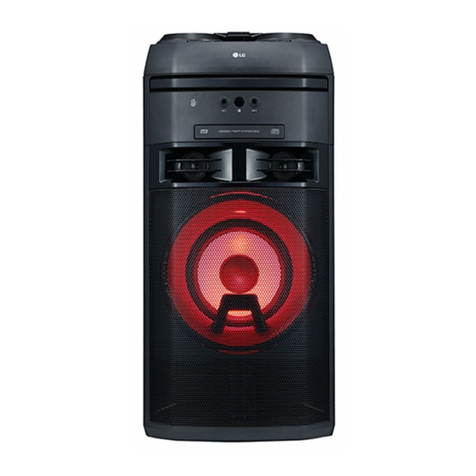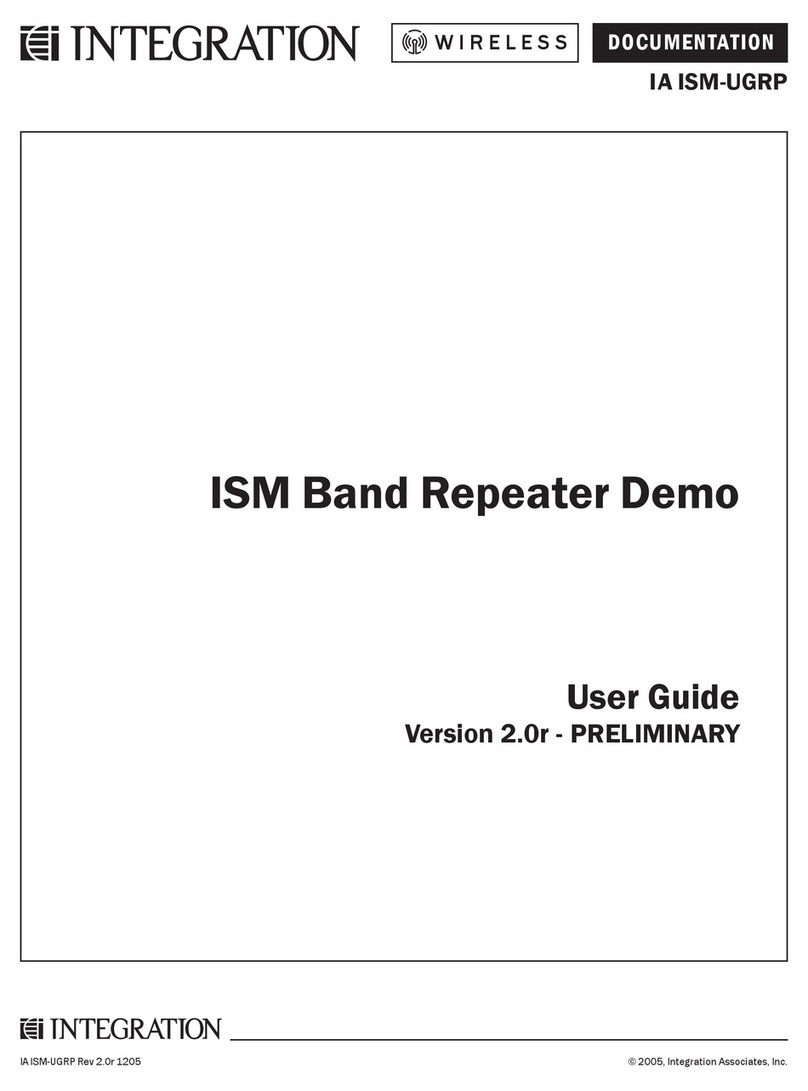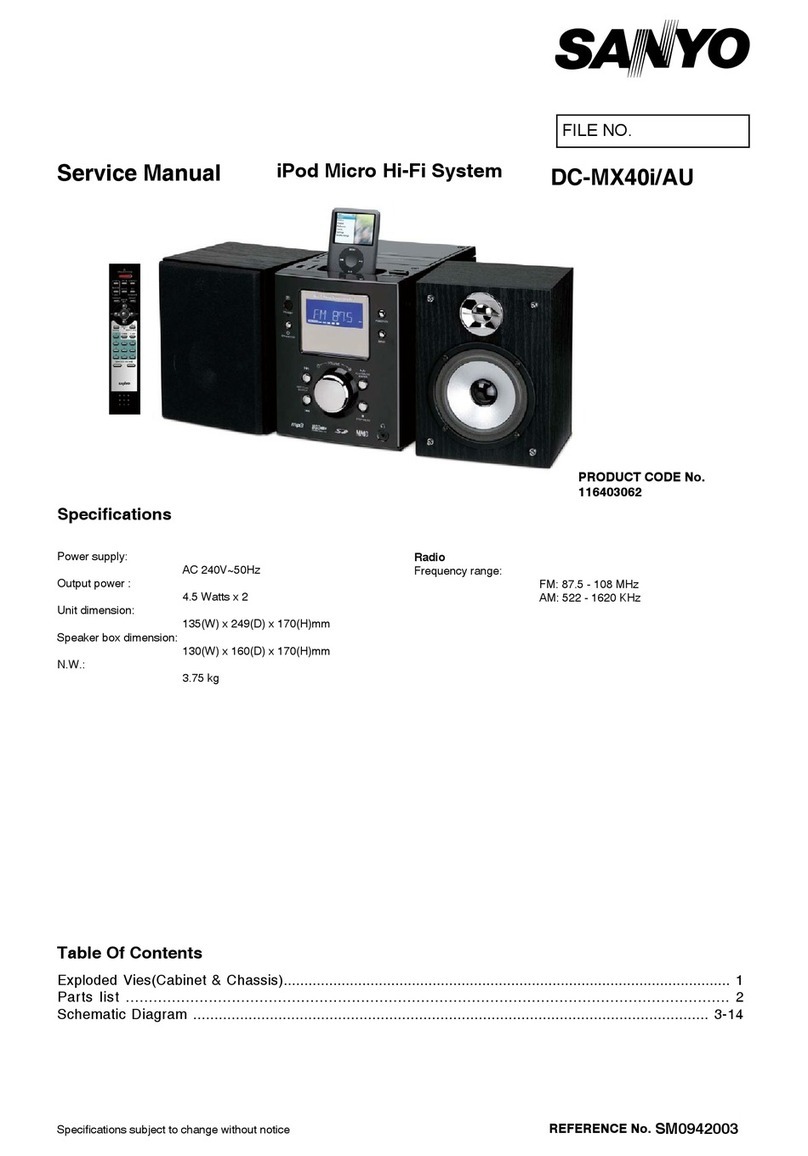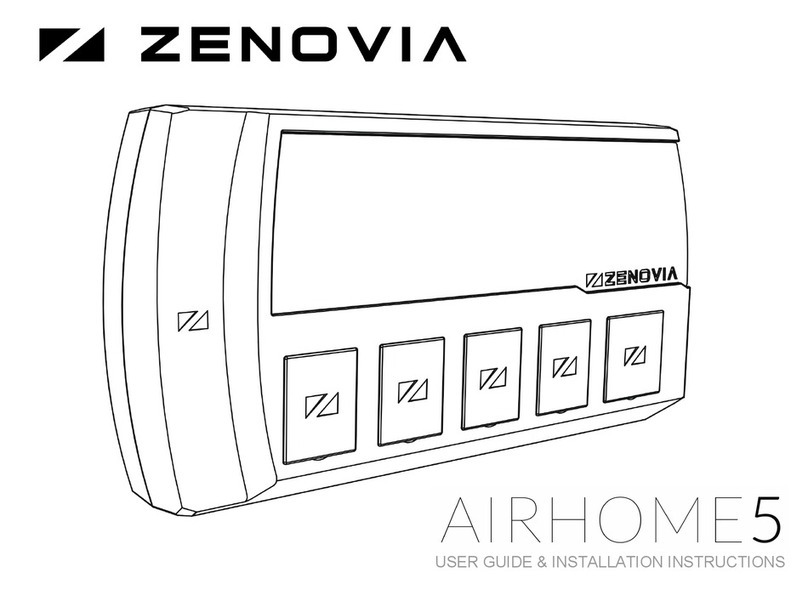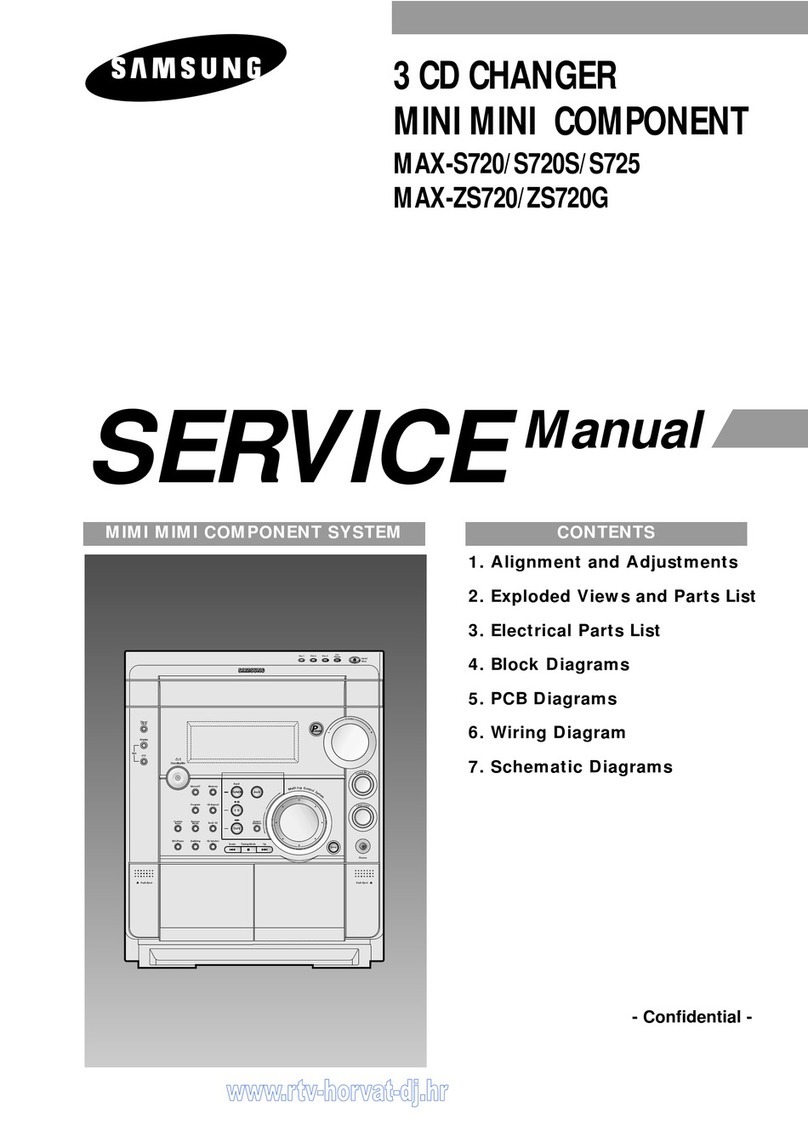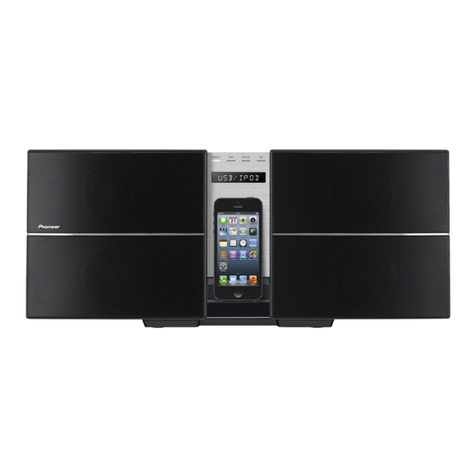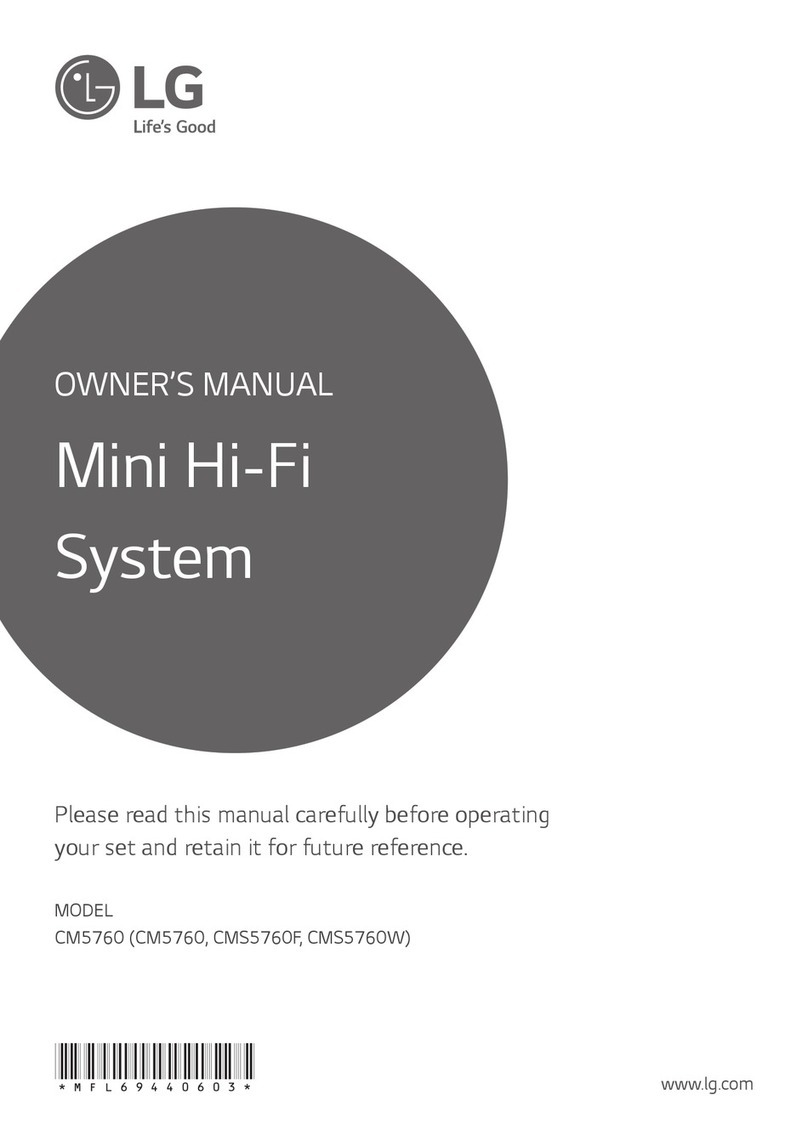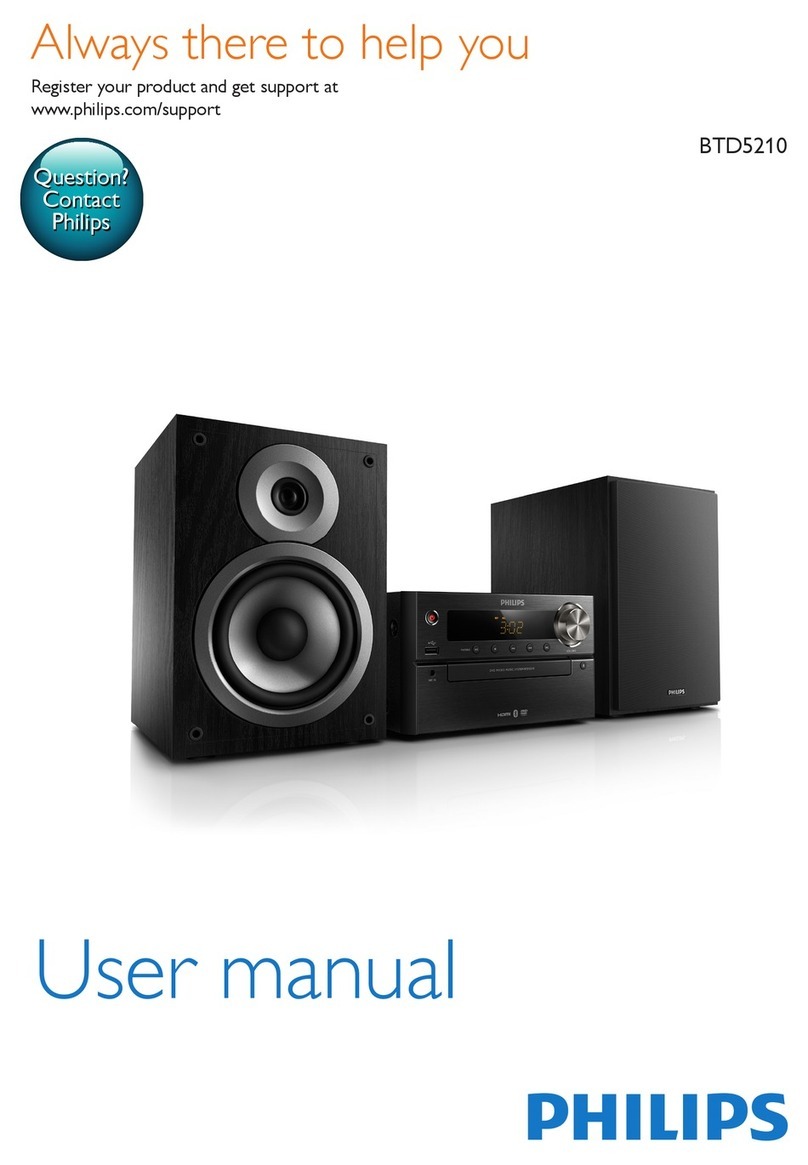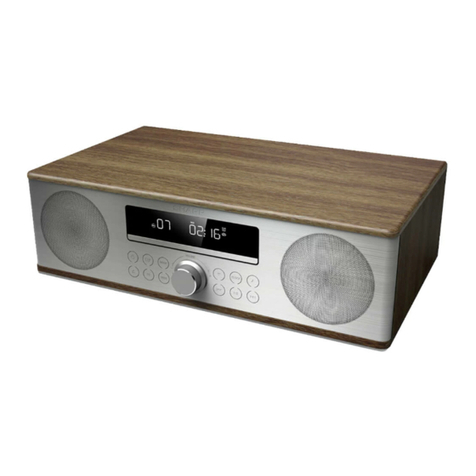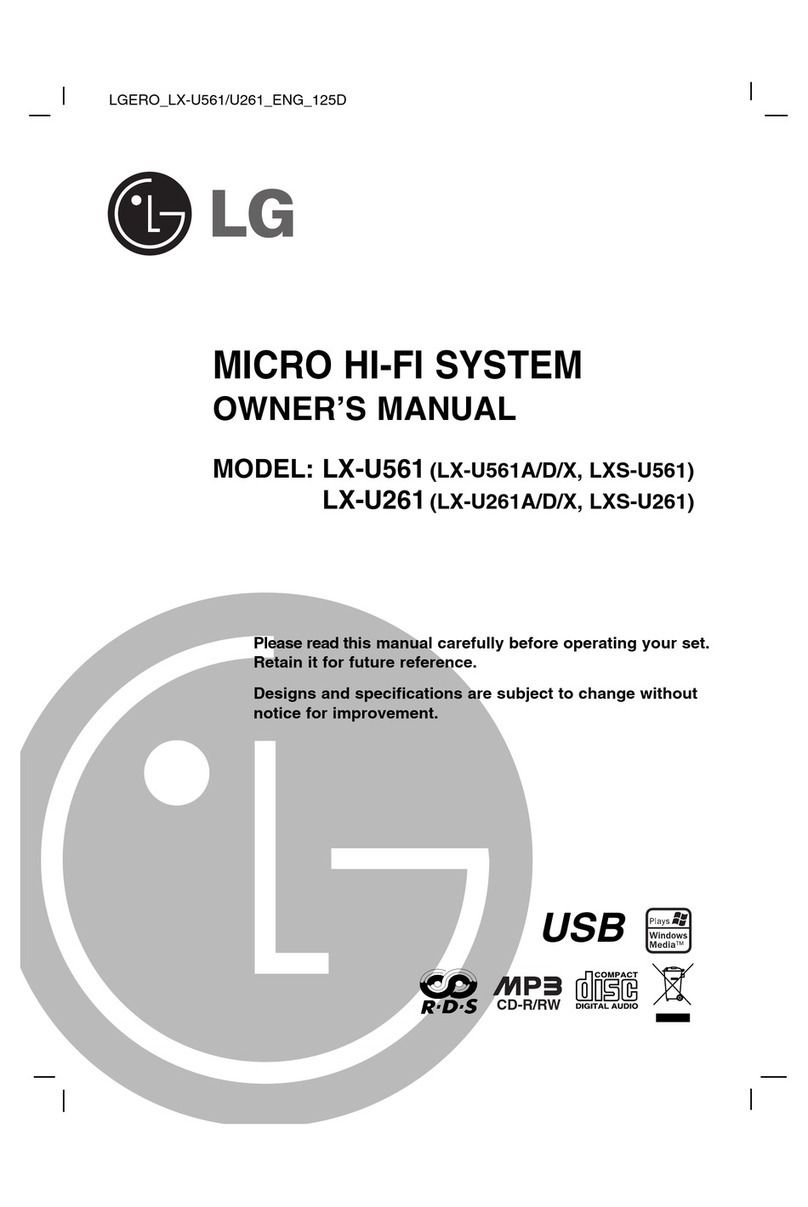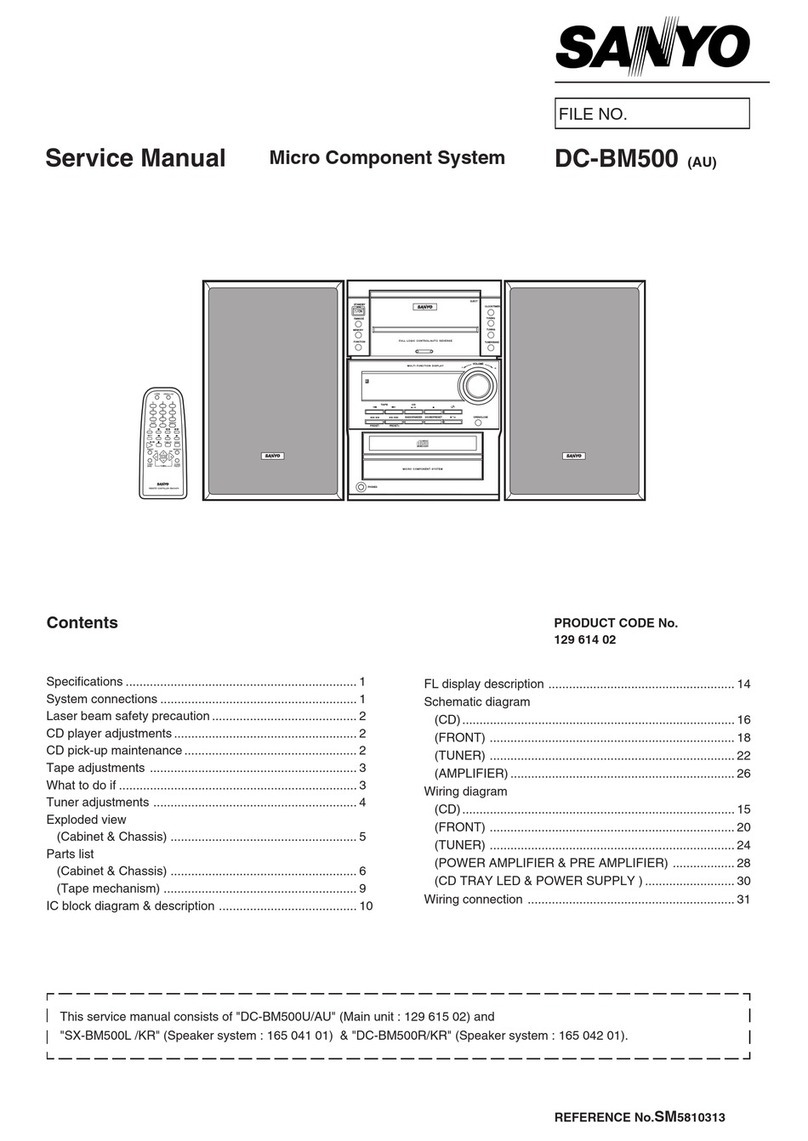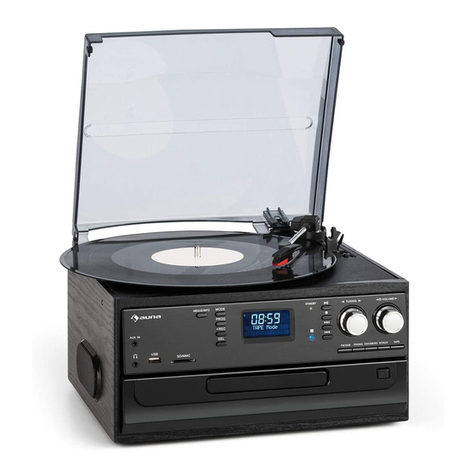PS Engineering PM3000 User manual

9800 Martel Road
Lenoir City, TN 37772
PM3000
High-fidelity Stereo 6-place Intercom System
Operation and Installation Manual
Document P/N 200-193-0000
Revision 0 May 1998
PS Engineering, Inc. 1998 ©
Copyright Notice
Any reproduction or retransmittal of this publication, or any portion thereof, without the expressed written permission of PS
Engineering, Inc. is strictly prohibited. For further information contact the Publications Manager at PS Engineering, Inc., 9800
Martel Road, Lenoir City, TN 37772. Phone (423) 988-9800

PS Engineering Incorporated
PM3000
Installation and Operation Manual
200-193-0000 page i Rev. 0, May, 1998
Table of Contents
1. SECTION I GENERAL INFORMATION 1
1.1 INTRODUCTION 1
1.2 SCOPE 1
1.3 DESCRIPTION 1
1.4 APPROVAL BASIS 2
1.5 SPECIFICATIONS 2
1.6 EQUIPMENT REQUIRED BUT NOT SUPPLIED 2
1.7 LICENSE REQUIREMENTS 2
2 SECTION II INSTALLATION 1
2.1 GENERAL INFORMATION 1
2.2 UNPACKING AND PRELIMINARY INSPECTION 1
2.3 EQUIPMENT INSTALLATION PROCEDURES 1
2.4 CABLE HARNESS WIRING 2
2.4.1 ELECTRICAL NOISE ISSUES 2
2.4.2 POWER REQUIREMENTS 2
2.4.3 SIDETONE 3
2.4.4 ENTERTAINMENT INPUT 3
2.4.5 EXTERNAL PTT HOOK-UP 3
2.5 POST INSTALLATION CHECKOUT 4
3. SECTION III OPERATION A
3.1 ADJUSTING THE VOLUME A
3.2 ADJUSTING THE SQUELCH CONTROL A
3.3 MODE SELECT A
4. SECTION 4 WARRANTY AND SERVICE B
4.1 WARRANTY B
4.2 FACTORY SERVICE B
5. APPENDIX A —PTT MODIFICATIONS C
6. APPENDIX B INSTRUCTIONS FOR FAA FORM 337 C
7. APPENDIX C, INSTRUCTIONS FOR CONTINUING AIRWORTHINESS D
8. APPENDIX D WIRING DIAGRAM D

PS Engineering Incorporated
PM3000
Installation and Operation Manual
200-193-0000 page 1 Rev. 0, May, 1998
1. Section I General Information
1.1 Introduction
The PM3000 is a panel mounted, 6-place high-fidelity stereo intercom system (ICS). Please read this
manual completely before installation to minimize the risk of damage to the unit and to become familiar
with all the features.
1.2 Scope
This manual contains installation and operational instructions for the following PS Engineering unit:
Model Description Part Number
PM3000 6-place intercom system 11930
1.3 Description
The PM3000 is a 6-place, panel-mounted intercom with multiple volume and VOX (voice activated
squelch) circuits using unified volume and squelch controls for the pilot, copilot and passengers.
With few controls for the pilot to use, the operation of the PM3000 is very straightforward. Yet the unit
outperforms its much more complicated competition. Although there is only one volume control knob,
when an adjustment is made to the volume control, many output amplifiers are being changed
simultaneously. Likewise, when the squelch control knob is adjusted, several VOX circuits are being
changed at the same time. Since the system is designed to use modern stereo headsets, it is not necessary
to balance the volume and squelch controls at the intercom.
A 3-position mode switch allows the pilot to select different configurations. The "ALL" mode places all
headsets on a party line. In the "ISO" mode, the pilot is isolated from all others and is connected to the
aircraft radio allowing un-interrupted radio communications. The third mode known as the "CREW"
mode allows the pilot and copilot to be isolated from the other positions.
The PM3000 has an automatic fail-safe interconnect to the aircraft radios. If power is disrupted to the
intercom for any reason, an internal relay will connect the pilot's headset to the aircraft radio allowing
continued radio communications.
A 2-color LED is green when power is on and changes to red when a Push to talk is pressed.
Provision for entertainment input allows the pilot, copilot and passengers the option to listen to music
during flight. During intercom or aircraft radio reception, this music will automatically mute to allow
communications without distraction. When the activity ceases, the Soft Mute™ circuit gradually returns
the music to the original listening volume. By depressing the “Mute” control (located on the Squelch
knob) once, it is possible to have the music remain at a constant level, regardless of any ICS or radio
traffic.
During various phases of flight, the degree of importance of the aircraft radio will vary. Because the "ISO"
mode connects the Pilot directly to the aircraft radio, select the "ISO" mode when the Pilot must have top
priority on radio transmissions.
Both pilot and copilot have transmit capabilities over the radio. The PM3000 only allows the voice of the
person who presses their PTT to be transmitted over the aircraft radio. If both pilot and copilot press the

PS Engineering Incorporated
PM3000
Installation and Operation Manual
200-193-0000 page 2 Rev. 0, May, 1998
PTT at the same time, the copilot will override. When either pilot or co-pilot presses PTT, all other
microphones are disabled. The pilot can regain priority by switching the unit off.
1.4 Approval Basis
Pending 1.5 Specifications
Input power: 13.8 - 27.5 Volts DC
Current Drain: < 200 mA (Externally fused at 1 Amp)
Headphone Impedance: 150-1000 (typical)
Audio Distortion: <3% @ 75mW into 150 load
Aircraft Radio Impedance: 1000 (typical)
Mic Frequency Response: ±3 dB, 350 Hz —6000 Hz
Music Frequency Response ±3 dB, 200 Hz –15kHz
Unit weight: 12 Ounces (0.34 kg)
Dimensions: 1.25" H x 3.00" W x 5.50" D (3.2 x 7.6 x 14.0 cm)
Environmental and technical qualifications: RTCA DO-160C/DO-214
Temperature -20º to +55ºC
1.6 Equipment required but not supplied
A. Interconnecting cables as required (may be ordered from PS Engineering)
B. Headphones, 150
stereo, up to six as required
C. Microphones, up to six, as required
D. Interconnect wiring
E. Circuit Breaker 1 Amp.
1.7 License Requirements
None

PS Engineering Incorporated
PM3000
Installation and Operation Manual
200-193-0000 Page 1Rev. 0, May 1998
2 Section II Installation
2.1 General Information
The PM3000 comes with all mounting hardware and jacks for installation. Installation of the PM3000,
using the hardware supplied and available wiring does not require special tools or knowledge other than
described in FAA Advisory Circular 43.13-2. It is the installer's responsibility to determine the approval
basis for this installation. An FAA Form 337, or other approval may be required. See Appendix B for
example of FAA Form 337.
2.2 Unpacking and preliminary inspection
The PM3000 was carefully inspected mechanically and thoroughly tested electronically before shipment.
It should be free of electrical or cosmetic defect.
Upon receipt, verify that the parts kit (p/n 250-001-0001) includes the following:
PM3000 Installation Kit: 250-001-0001
Part Number
Description
Quantity
475-440-0318
#4-40 Machine screws, black
2
625-003-0002
Knobs (Soft Touch)
2
430-003-0003
PM3000 faceplate (Aluminum)
1
425-025-0002
25 pin Sub-D male connector
1
425-025-0003
Connector hood
1
475-002-0000
Connector Thumbscrews
2
200-193-0000
Operator's and Installation Manual
1
122-001-0000
Drill Template
1
250-000-0061
6-place jack kit containing the following
X
475-003-0002
Insulated Shoulder Washers
12
475-003-0003
Insulated Flat Washers
12
550-001-0002
Stereo Headphone Jack
6
550-001-0003
Microphone Jack
6
550-008-0001
Music Input Jack ?”
2
2.3 Equipment installation procedures
0.250
2 ea. 0.125
0.297
2 ea. 0.314
1.200
”
1.200
”
0.838
0.838
0.325
NOT TO SCALE
Figure 1-1 Hole Spacing
1. Using the template, drill six holes in the instrument panel in a location convenient to the pilot
position(s).

PS Engineering Incorporated
PM3000
Installation and Operation Manual
200-193-0000 Page 2Rev. 0, May 1998
2. Insert the PM3000 from behind the instrument panel, aligning the holes for the knobs, LED, and
switch.
3. Place the aluminum plate over the knob shafts and secure, using the two # 4-40 round head screws
provided.
4. Install the knobs over the volume and squelch control shafts.
5. Complete a wiring harness in accordance with Appendix D.
2.4 Cable harness wiring
To complete the installation, a wire harness must be made as shown in Appendix D.
Note:
PS Engineering can make a custom-tailored wiring harness for the installer. All harnesses use
Mil-spec quality components with professional techniques, and are fully tested before shipment.
Contact PS Engineering for more information.
If the aircraft already has pilot and copilot headset jacks installed, you may re-use them. Remove and
discard all wires from the copilot headset jacks. You may use the existing pilot headset jacks as the
Auxiliary Aircraft Radio Headset Jacks, but they should be moved to a new location to avoid confusion
with the pilot's headphone jacks. In the event the intercom has to be removed for any reason, these jacks
provide access to the aircraft radio system.
To connect intercom into the aircraft audio system, parallel the appropriate set of cables from the intercom
to the Auxiliary Aircraft Radio Headset Jacks. Finally, install new headset jacks into the aircraft and
connect them directly to the appropriate pins of the PM3000. See the wiring diagram for all details of the
wire harness interconnect.
2.4.1 Electrical Noise Issues
WARNING: You must use individual shielded cables for the microphone and headphone jacks.
Combining these two wires WILL cause loud oscillations and degrade the intercom function. The
oscillation is caused by the cross-coupling between the large headphone signal and the small microphone
signal. The resulting feedback is a high-pitched squeal that varies with the volume control.
Due to the variety of the radio equipment found in today's general aviation aircraft, there is the potential
for both radiated and conducted noise interference. The PM3000 has a specially designed power supply to
reduce conducted electrical noise on the power bus of the aircraft by at least 50dB. Although this is a very
large amount of attenuation, it does not eliminate all noise when the amount is excessive. There must be
at least 13.75 Volts DC present at the PM3000 for the power supply to work within its designed
regulation. Otherwise, it will not be able to attenuate noise properly.
Shielding can protect the system from radiated noise (rotating beacon, electric gyros, switching power
supplies, etc.). However, installation combinations can occur where minor interference is possible. The
PM3000 was designed in an interference -protected chassis and has internal filter capacitors on all input
lines.
Ground loop noise occurs when there are two different return paths for the same signal, such as airframe
and ground return wire. Large cyclic loads such as strobes, inverters, etc., can inject audible signals onto
the airframe return path. Follow the wiring diagram very carefully to help insure a minimum of ground
loop potential. Radiated signals can be a factor when low level microphone signals are bundled with
current carrying power wires. Keep these cables separated.
Insulating washers are required on all microphone and headphone jacks to isolate them from aircraft
ground. The use of a conductor instead of a shield for ground return eliminates these ground loop paths.

PS Engineering Incorporated
PM3000
Installation and Operation Manual
200-193-0000 Page 3Rev. 0, May 1998
2.4.2 Power Requirements
The PM3000 was designed to work with 12.8 to 27.5 volt DC negative ground systems. The PM3000
must be externally protected with a one ampere (1A) circuit breaker or fuse.
2.4.3 Sidetone
The PM3000 can be modified to produce sidetone (hearing your voice during transmit), if the aircraft
radios do not produce it. Contact the PS Engineering factory for details.
2.4.4 Entertainment Input
Two stereo entertainment devices can be connected to the PM3000. Install two ?" stereo jacks convenient
the pilot and passengers to connect the entertainment devices into the system.
It is possible to use only one entertainment device by connecting the output of the entertainment device in
parallel to both the Music #1 and Music #2 inputs. We highly recommend, however, that you install a
switch between the entertainment device and Music #1. This will give the pilot and copilot the ability to
switch off music while in the CREW mode.
The music device will automatically mute when the ICS or aircraft radio becomes active. The Soft Mute™
feature slowly returns the music to full volume when the activity ceases. Pressing the Mute disable switch
(located on the squelch control) in once can inhibit this feature. Music #2 (for the passengers) will always
be muted during conversation and is heard only while the intercom is in the Crew mode.
Use only low level output of the entertainment devices to connect to the PM3000. Maximum signal level
on the input is 1 volt peak-to-peak.
DO NOT USE SPEAKER OUTPUT LEVELS.
This will cause internal damage.
Local oscillators and other internal signals from CD or radio equipment can cause undesired interference
with VHF navigation and communication equipment. Before takeoff, operate the entertainment device to
determine if there is any adverse effect on aircraft systems. If any unusual operation is noted in flight,
immediately switch the entertainment device off.
2.4.5 External PTT hook-up
Part of the installation includes the installation of PTT (Push To Talk) switches that allow radio
transmissions from pilot and copilot positions.
There are three configurations that can be used. You must select the case that best fits your installation.
NOTE: Only the person who presses their PTT switch will be heard over the radio.
CASE I
The PTT is built into the pilot and copilot yokes
Simply install the plugs from the headset into the aircraft headphone jacks. Then use the yoke mounted
PTT to transmit. No other action is required.
CASE II
Built in PTT only on the pilot side

PS Engineering Incorporated
PM3000
Installation and Operation Manual
200-193-0000 Page 4Rev. 0, May 1998
This configuration requires a modified external PTT switch plugged into the copilot's mic jack. (See
Appendix A) When the copilot's PTT is depressed, this activates an internal relay that switches the mic
audio to the aircraft radio from the pilot to the copilot.
Case III
No built in PTT switch at all.
Two built-in PTT must be installed or two external, modified PTT switches will be required for both the
pilot and copilot. Modifications to the PTT may be required. (See Appendix A)
2.5 Post installation checkout
After wiring is complete, verify power is ONLY on pin 13 of the connector, and airframe ground on pin 1.
Failure to do so will cause serious internal damage and void PS Engineering's warranty.
1. Apply power to the aircraft and avionics.
2. Plug headsets into the pilot, copilot and passenger positions.
3. Verify that the pilot position can transmit and receive with the PM3000 in the OFF position (left
hand knob controls on/off).
4. Push the volume knob to switch the PM3000 on. Rotate the volume clockwise, about half way.
Verify that the Pwr/Xmt light comes on green. If the LED is red, immediately switch off the
avionics, and troubleshoot the PTT installation.
5. Verify that the pilot can transmit and receive on the com transceivers.
6. Verify proper intercom operation for pilot, copilot and passengers. For more information, consult
Section 3.
7. Verify proper transmit and receive operation on the copilot position, noting that the copilot PTT
switch allows proper transmission.
8. Verify proper Intercom system operation in the ALL, CREW and ISO modes.
9. Verify that the intercom system does not adversely affect any other aircraft system by
systematically switching the unit on and off, while monitoring the other avionics and electrical
equipment on the aircraft.

PS Engineering Incorporated
PM3000
Installation and Operation Manual
200-193-0000 Page ARev. 0, May 1998
3. Section III OPERATION
With the installation is complete, turn the PM3000 on by pushing the volume control. This also engages
the automatic fail-safe system. The intercom volume control does not control the volume of the aircraft
radio, allowing an additional degree of aircraft radio listening flexibility.
Figure 2 PM3000 front panel controls
3.1 Adjusting the Volume
The PM3000 volume control knob adjusts the loudness of the intercom and music only. The volume
control on the PM3000 does not affect the volume level of the aircraft radio. This provides the ability to
adjust the aircraft radio and the ICS volume independently. The volume control affects the music level for
the pilot and copilot positions.
By turning the control clockwise, the audio level will increase. The PM3000 has individual output
amplifiers for each headset in the system that provides plenty of audio output power. NOTE: Volume
level will not change with the number of headset installed.
Passenger music volume (through Music # 2) is a fixed level, and controlled locally by the headphone
volume control
3.2 Adjusting the Squelch Control
This VOX operated intercom keeps all microphone channels off (silent) while the pilot, copilot or
passengers are not speaking. This reduces background noise from the aircraft. Only when someone speaks
will his or her microphone turn on and allow the audio to pass through the system. Although there is just
one squelch control, there are actually three separate squelch circuits. One circuit each for the pilot,
copilot, and passengers 1, 2, 3 and 4. Only the microphone actually in use is open, further reducing noise
in the system.
With the engine running, set the squelch control knob by slowly rotating the squelch control knob
clockwise until you no longer hear the background noise in the earphones. When the microphone is
positioned properly near the lips, normal speech levels should open the channel. When you have stopped
talking, there is a delay of about one half second before the channel closes. This prevents squelch closure
between words, and helps eliminate choppy intercom conversations.
3.3 Mode Select
The center switch is a three-position mode control that allows the pilot to tailor the intercom function to
suit flight conditions. Regardless of configuration, the pilot will always hear the aircraft radio. NOTE: If
there is a power failure to the PM3000, or if the power switch is turned off, the copilot will not hear the
aircraft radio. Only the pilot is connected directly to the aircraft radio.

PS Engineering Incorporated
PM3000
Installation and Operation Manual
200-193-0000 Page BRev. 0, May 1998
ISO (Up Position): The pilot is isolated from the intercom and is connected only to the aircraft radios. He
will hear the aircraft radio reception (and sidetone during radio transmissions). Copilot and passengers
will hear themselves and music but not the aircraft radio traffic.
ALL (Middle position): All parties will hear the aircraft radio, intercom, and music. However, during
any ICS conversation, the music volume automatically mutes. The music volume increases gradually back
to the original level after communications have been completed.
Mode
Pilot Hears
Copilot Hears
Passenger Hears
Comments
Isolate
A/C Radio,
Pilot Sidetone
(during radio
transmission)
Copilot and passenger
intercom,
Music #1
Passenger and Copilot
intercom,
Music #1
This mode allows the pilot
to communicate with the
ground without the copilot
or passengers bothered
by the conversations.
Copilot and passengers
continue to communicate
and listen to music #1
All
Pilot,
Copilot,
A/C Radio,
Passengers,
Entertainment #1
Copilot,
Pilot,
A/C Radio,
Passengers,
Entertainment #1
Passengers,
Pilot,
Copilot,
A/C Radio,
Entertainment #1
This mode allows all on
board to hear radios as
well as communicate on
the intercom. Music and
intercom is muted during
intercom and radio
communications
Crew
Pilot,
Copilot,
A/C Radio
Entertainment #1
Copilot,
Pilot,
A/C Radio
Entertainment #1
Passengers,
Entertainment #2
A second music source is
automatically enabled for
the passengers.
4. Section 4 Warranty and service
4.1 Warranty
In order for the factory warranty to be valid, the installations in a certified aircraft must be accomplished
by an FAA- certified avionics shop and authorized PS Engineering dealer. If the unit is being installed by
a non-certified individual in an experimental aircraft, a factory-made harness must be used for the
warranty to be valid.
PS Engineering, Inc. warrants this product to be free from defect in material and workmanship for a
period of one year from the date of installation. During this one year warranty period, PS Engineering,
Inc., at its option, will send a replacement unit at our expense if the unit should be determined to be
defective after consultation with a factory technician.
This warranty is not transferable. Any implied warranties expire at the expiration date of this warranty.
PS Engineering SHALL NOT BE LIABLE FOR INCIDENTAL OR CONSEQUENTIAL DAMAGES.
This warranty does not cover a defect that has resulted from improper or unreasonable use or maintenance
as determined by us. This warranty is void if there is any attempt to dissemble this product without factory
authorization. This warranty gives you specific legal rights, and you may also have other rights, which
may vary from state to state. Some states do not allow the exclusion of limitation of incidental or
consequential damages, so the above limitation or exclusions may not apply to you.
4.2 Factory Service
The PM3000 is covered by a one-year limited warranty. See warranty information.
Call PS Engineering, Inc. at (423) 988-9800 before you return the unit. This will allow the service
technician to provide any other suggestions for identifying the problem and recommend possible solutions.

PS Engineering Incorporated
PM3000
Installation and Operation Manual
200-193-0000 Page CRev. 0, May 1998
After discussing the problem with the technician and you obtain a Return Authorization Number, ship
product to:
PS Engineering, Inc.
Service Department
9800 Martel Road
Lenoir City, TN 37772
(423) 988-9800 FAX (423) 988-6619
5. Appendix A —PTT Modifications
When received from the manufacturer, an after-market PTT switch opens the mic audio path to the "ring"
connection of the PTT mic plug. When the PTT is between the intercom and the headset, the intercom
function will not work until the PTT switch is depressed. A simple modification can be performed to allow
proper intercom operation. NOTE: This mod does not alter normal operation. The following are sample
procedures for common PTT switches. Contact the PTT manufacturer if you require more information.
Procedures for the David Clark PTT
1. Unscrew the round black plastic cover from the jack.
2. Connect the joined black wires to the red wire
3. Replace the plastic cover.
Procedures for the Telex PT-200
1. Unscrew the round black plastic cover from the jack.
2. Cut the red wire in the middle of the wire.
3. Strip both ends of the insulation.
4. Solder the two ends to the ground lug to the PTT jack
5. Replace the plastic cover.
Procedures for the Telex PT-300
1. Unscrew the round black plastic cover from the jack.
2. Remove the heat shrink material from the joined black wires.
3. Solder these two wires to the lug that has a white wire already soldered to it.
4. Replace the plastic cover.
6. Appendix B Instructions for FAA Form 337
One method of airworthiness approval is through an FAA Form 337, Major Repair and Alteration
(Airframe, Powerplant, Propeller, or Appliance) In the case of the PMA3000, 11930, you may use the
following text as a guide.
Installed 6-place intercom, PS Engineering PM3000, part number 11930 in ( location ) at
station . Installed per AC43.13-2, Chapter 2, paragraph 23 (Instrument Panel Mounting).
Installed per PS Engineering Installation Operators Manual p/n 200-193-0000, revision 0, dated
May 1998.
This unit is FAA-Approved under TSO C50c for audio amplifiers, and meets environmental tests
outlined in RTCA DO-160C as appropriate or this aircraft.
Interface to existing aircraft radios in accordance with manufacturer’s installation manual and in
compliance with practices listed in AC43.13-2, Chapter 2. All wires are Mil-Spec 22759 or
27500. No connection to the aircraft dimmer bus is required. Power is supplied to the unit
through a 1A circuit breaker (type and part number), and total electrical load does not exceed
% of the electrical system capacity with the PMA1000 added.

PS Engineering Incorporated
PM3000
Installation and Operation Manual
200-193-0000 Page DRev. 0, May 1998
Aircraft equipment list, weight and balance amended. Compass compensation checked. A copy of
the operation instructions, contained in PS Engineering document 200-193-0000, revision 0, May
1998, is placed in the aircraft records. All work accomplished listed on Work Order
..

PS Engineering Incorporated
PM3000
Installation and Operation Manual
200-193-0000 Page ERev. 0, May 1998
7. Appendix C, Instructions for continuing airworthiness
The PM3000 is considered an “on-condition” maintenance item. It is checked prior to each flight during
normal operation. There are no additional considerations for continuing airworthiness other than the
practices detailed in AC 43.13-1A, Chapter 15, Paragraph 750. This includes inspecting the unit to be
sure it is securely fastened in its location, and that the wiring harness is not chafed or pinched, and
remains secure. All panel jacks should be checked at each periodic inspection to ensure that they are tight
and not in contact with other items behind the instrument panel.

PS Engineering Incorporated
PM3000
Installation and Operation Manual
200-193-0000 Page FRev. 0, May 1998
8. Appendix D Wiring Diagram
Copilot PhoneAudio (L)
Copilot PhoneAudio (R)
Copilot PhoneAudio Lo
Pass 1 & 3 Phone Audio ( L)
Pass 1 & 3 Phone Audio ( R)
Pass 1 PhoneAudio Lo
21
8
20
7
1A 11-33VDC13
1
14
PM3000Sub-D DB- 25 Male
Power In
Ground
A/C Radio Phone Audio Hi
A/C Radio Phone Audio Lo
A/C PTT
A/C Mi c Audio Hi
A/C Mi c Audio Lo T o A irc raf t R adi o Mic Au dio L o
T o A irc raf t R adi o
P hon e Low
12
25
A ircraft Ra dio P TT
T o A /C Ra dio Mic Au dio Hi
A ux Mi c J ac k
T o A irc raf t R adi o
P hon e Au dio Hi
Pilot Headphone Jack
22
9
Pilot Phones (L)
Pilot Phones (R)
Pilot Phones Lo
Copilot Headphone Jack
Passenger 1
Headphone
Pass 2 & 4 Phones Audio (L)
Pass 2 & 4 Phones Audio (R)
Pass Phones Audio Lo
19
6
Pass 1 Mic Audio Hi
Pass 1 Mic Audio Lo
15
Pass 2 Mic Audio Hi
Pass 2 Mic Audio Lo
2
P ilot M ic Jac k
Copi lot Mi c J ac k
10
23
Pilot PT T
Pilot Mic PTT
Pilot Mic Audio Hi
Pilot Mic Audio Lo
C opilot PT T
Copilot Mic PTT
Copilot Mic Audio Hi
Mic Audio Lo
16
3
Entertainment #1 Input
24
11
Music #1 (L)
Music #1 (R)
980 0 MA RTE L RO A D, L EN O IR C ITY T N 379 22
1
17/28/9 8
1
120-130-0000
PM300 0 (11930) WIRING DIAGRAM
SIZ E DO C UM ENT NUM B ER :
TITLE :
SH E ET OF
EC O
DA TE:
RE V
1. All wire must conform to MIL-22759
or 27500. Minumum 24 gage shielded wire.
2. Use 2-, and 3-, conductor with shield
as indicated.
3. Use insulating washers on all jacks. Jacks
must be electrically floating.
4. Connect shields at intercom end only
5. AUX headphone and microphone jacks are
required.
NOTES:
Passenger 3
Headphone
Passenger 2
Headphone
Passenger 4
Headphone
Pass 3 Mic Audio Hi
Pass 3 Mic Audio Lo
5
Pass 4 Mic Audio Hi
Pass 4 Mic Audio Lo
18
17
4
Music #1 (L)
Music #1 (R) Entertainment #2 Input
2- co nduct or w/s hi eld
3- co nduct or w/s hi eld
Other manuals for PM3000
2
Table of contents
Other PS Engineering Stereo System manuals
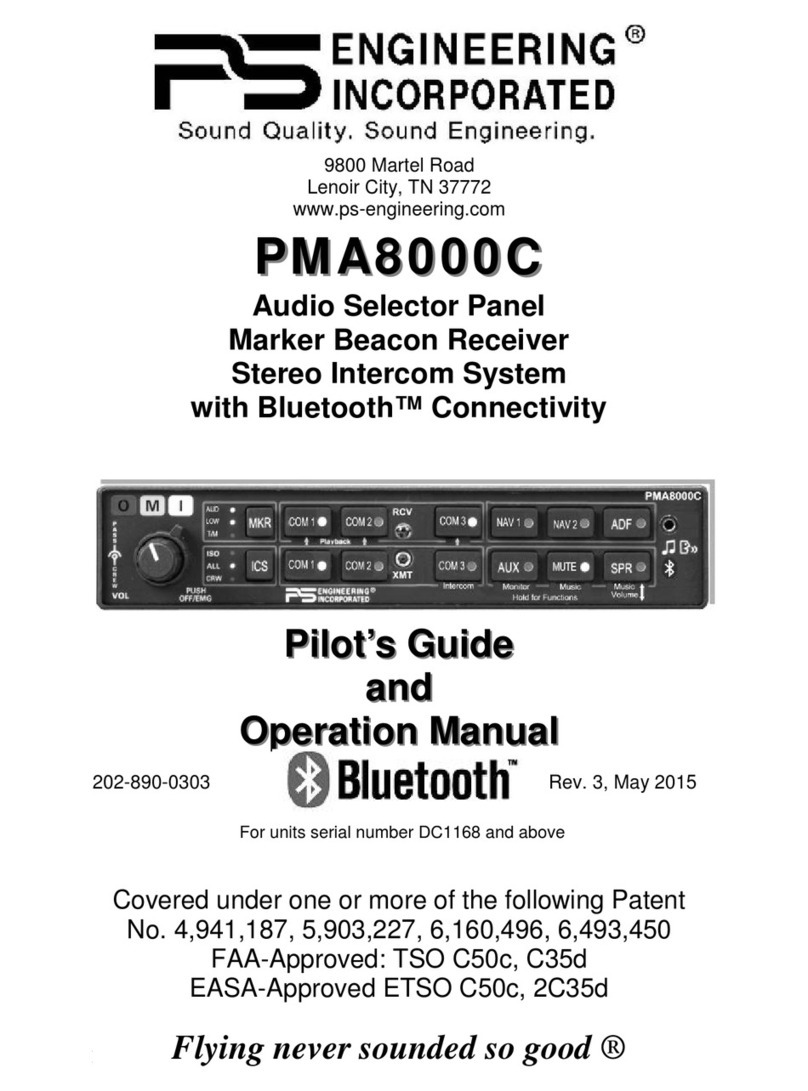
PS Engineering
PS Engineering PMA8000C User manual
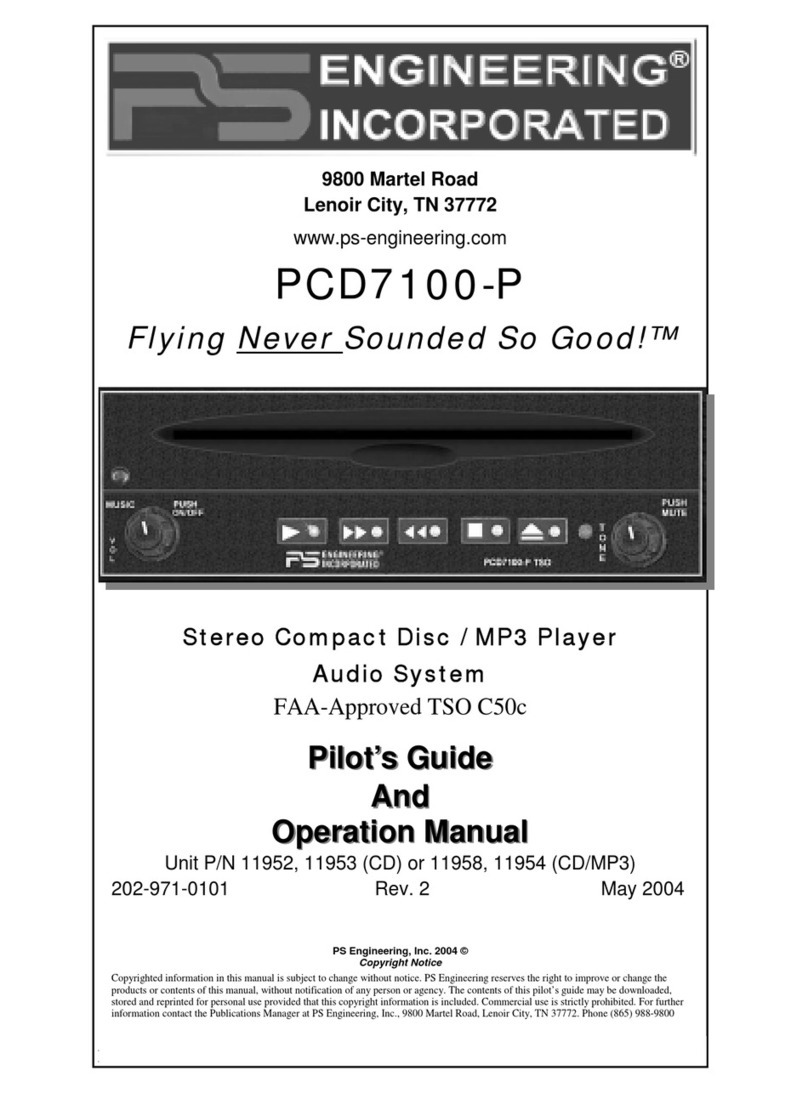
PS Engineering
PS Engineering PCD7100-P User manual
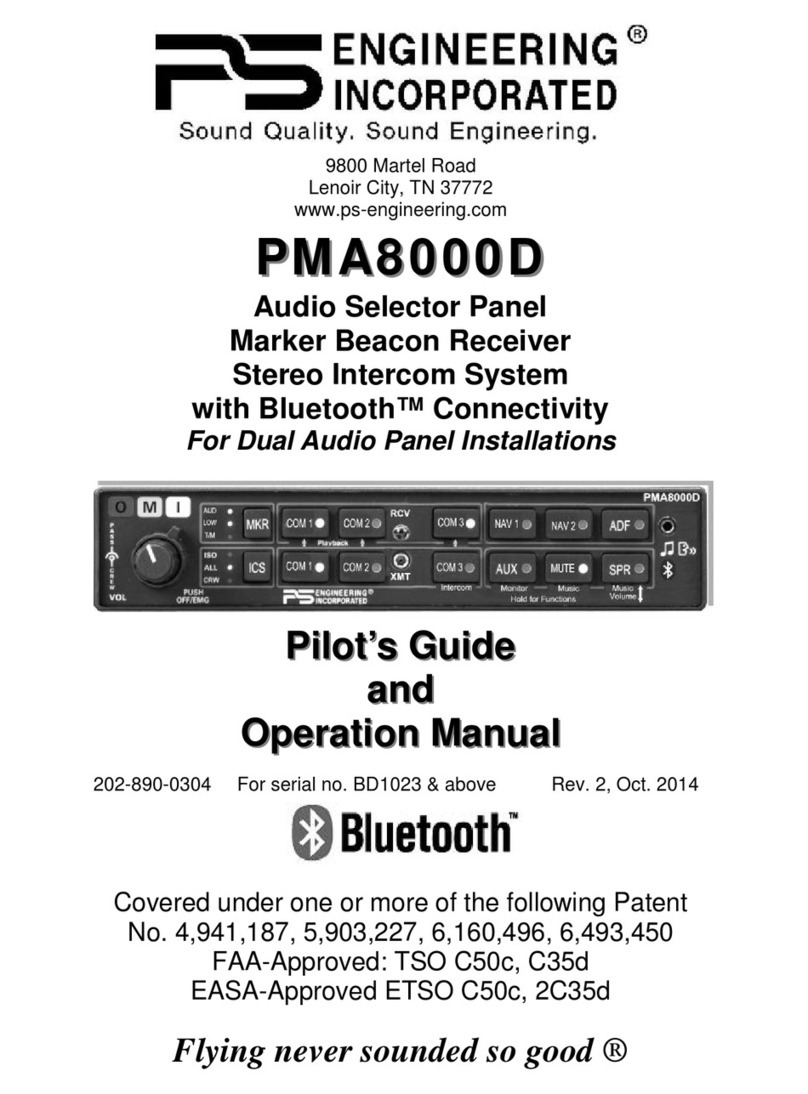
PS Engineering
PS Engineering PMA8000D User manual
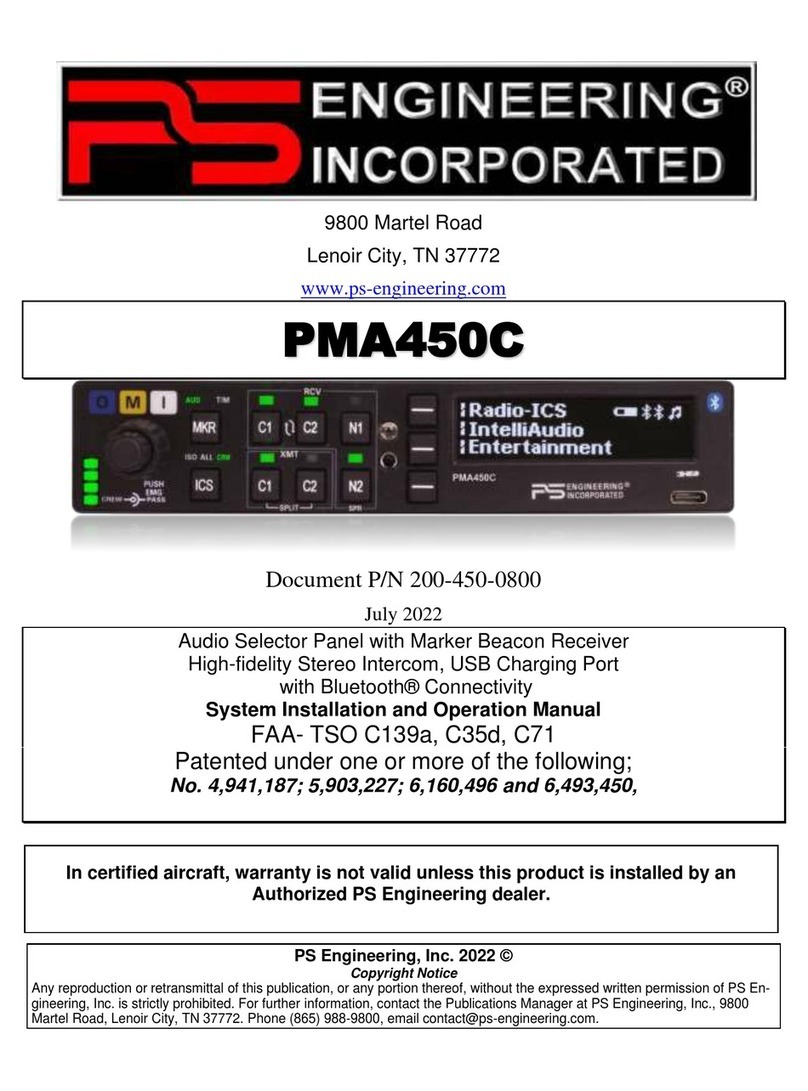
PS Engineering
PS Engineering 050-450-0801 User manual
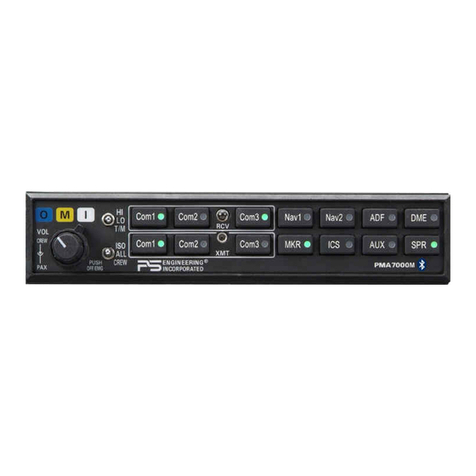
PS Engineering
PS Engineering PMA7000M User manual
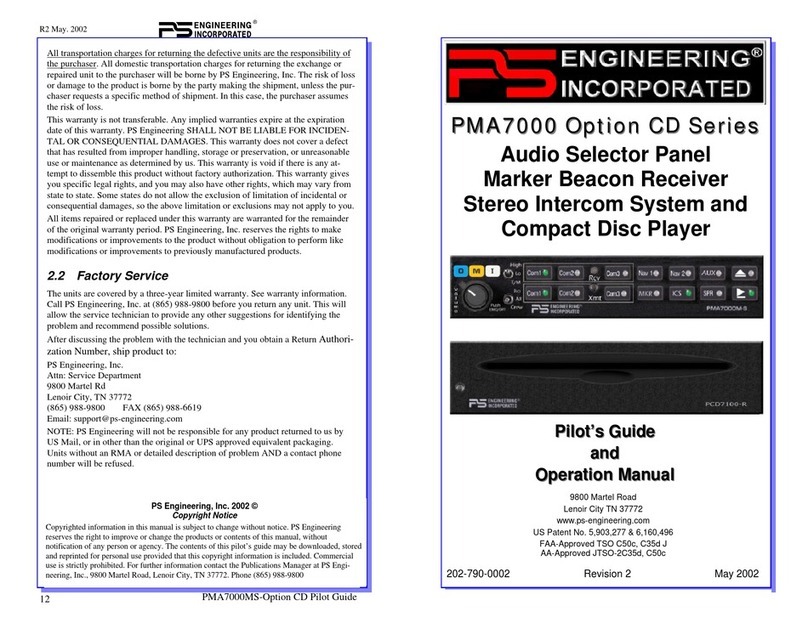
PS Engineering
PS Engineering PMA7000 Option CD Series User manual
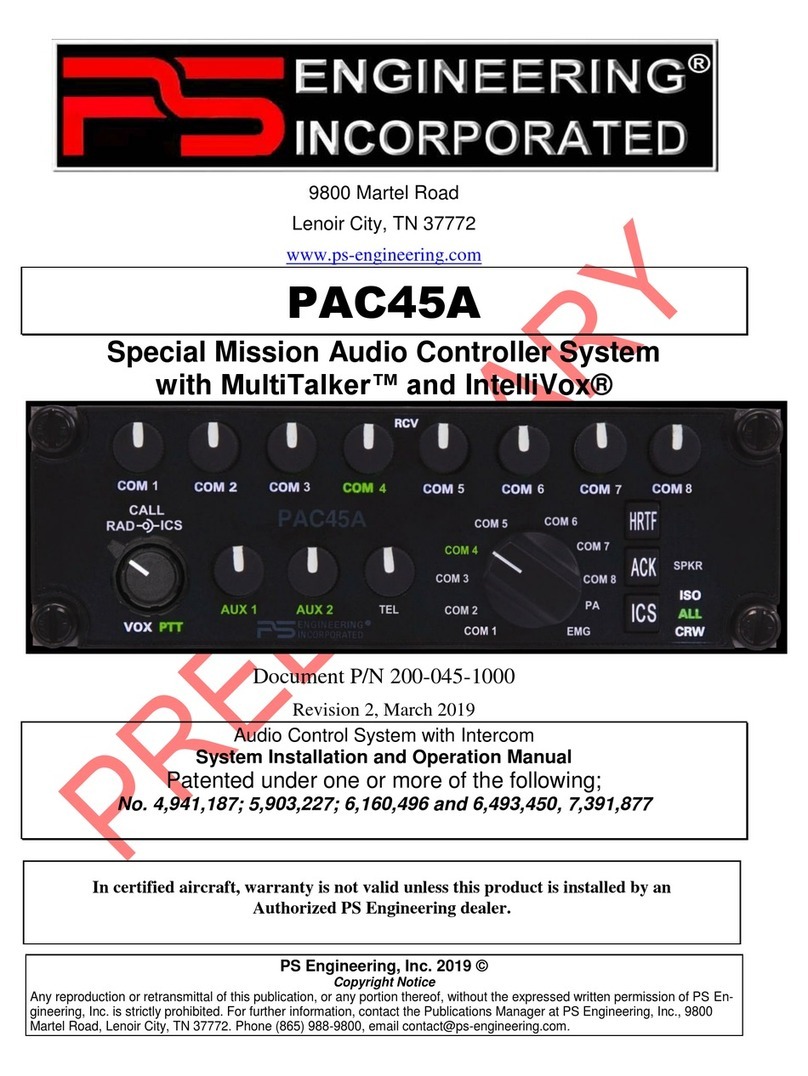
PS Engineering
PS Engineering PAC45A User manual

PS Engineering
PS Engineering PCD7100-P User manual
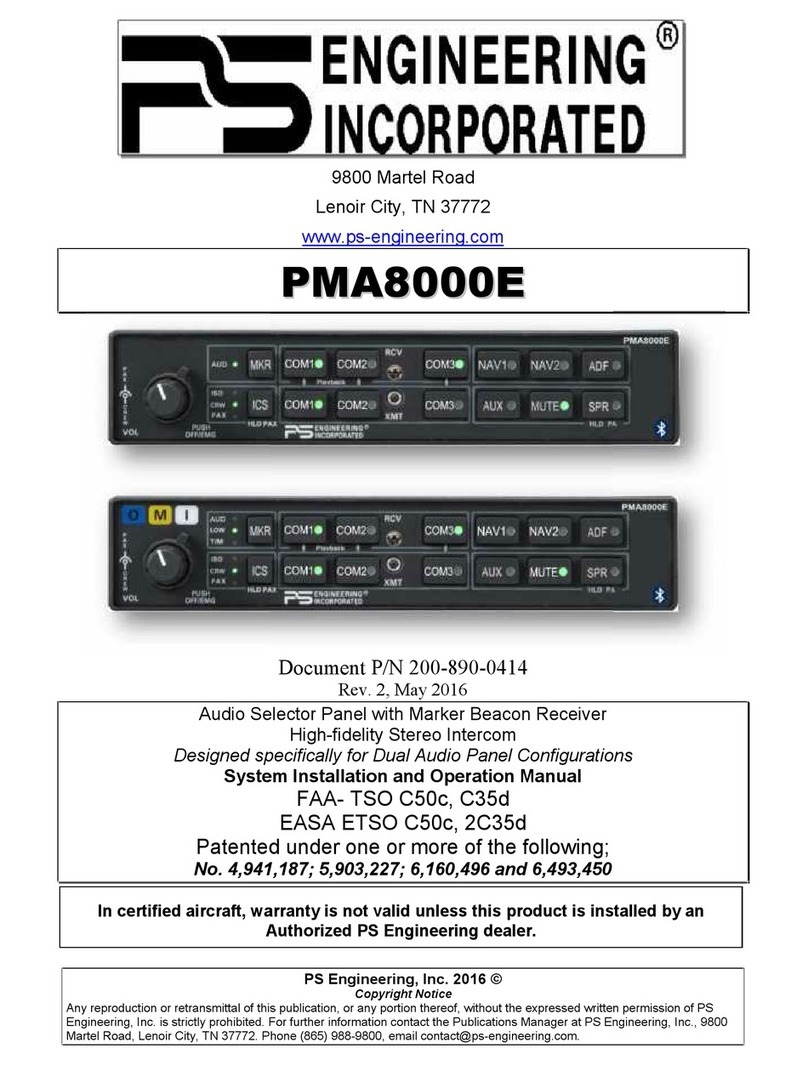
PS Engineering
PS Engineering PMA8000E User manual
